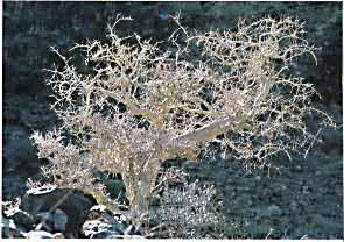Myrrh is a pale yellow sap collected from the stems of bushy shrubs found in southern Arabia and Somalia. The bushes do not grow more than 2.7m (9 feet) in height. They have with knotted branches and smaller branches that stand out at right-angles, ending in a sharp spine, with leaves that are small. Yellow-red flowers grow on stalks in an elongated and branching cluster. The sap is thick, yellow and sweet smelling and forms a reddish-brown mass the size of a walnut when it hardens.
The word myrrh means "bitter" in Arabic. Myrrh is one of the best antiseptics known, an astringent and a stimulant. It can be burned as incense, and is used to alleviate inflammation in the body. It is widely used today in oral hygiene products: it is an excellent mouthwash, good for treating gingivitis, bad breath, and is helpful for mouth sores or blisters, sore throats, bronchial congestion and other conditions requiring an antiseptic astringent.
Applied directly to skin burns, myrrh can reduce scars and to help in quickly healing wounds and to remove warts, and can be used on wrinkled, chapped or cracked skin
It is antifungal, and has been used to treat athlete's foot. It is said to relax smooth muscles, and stimulate gastric secretions. The myrrh resin has antimicrobial properties and acts to stimulate macrophage activity in the blood stream. The herb is being studied for its potential as an anticancer medication. In Chinese medicine, it is used for wounds, bruises, and bleeding.
Ancient Egyptians mixed myrrh, marjoram, and lotus as an ointment which they placed on their heads in the morning; and as the day grew hot, the ointment would slowly melt, running down the body, keeping the skin moist and repelling insects throughout the day.
Myrrh is referenced throughout the Old Testament and New Testament. It is one of the gifts of the Three Wise Men to the baby Jesus:
“They presented unto him gifts; gold, and frankincense and myrrh.” (Matthew 2:11)
Myrrh was also used to anoint Jesus' body after the crucifixion. Both Frankincense and myrrh were mentioned repeatedly in the Old Testament, in instructions to Moses about making incense and anointing oil, and in the Song of Solomon:
“Until the cool of the day
When the shadows flee away
I will go my way to the mountain of myrrh
And to the hill of frankincense."
Song of Solomon 4:6
The Muslim physician Al-Razi (Rhazes), perhaps the greatest of all medieval clinicians, used myrrh to treat ailments of the kidneys and bladder, to dissipate swellings in the stomach and for colic.
In Egypt today, traditional medicine practitioners use myrrh as a stimulant, expectorant, antispasmodic, antiputrescent, astringent, and to treat inflamed gums.
References: Saudi Aramco World, September/October 2006; http://www.answers.com/topic/myrrh; http://www.itmonline.org/arts/myrrh.htm


